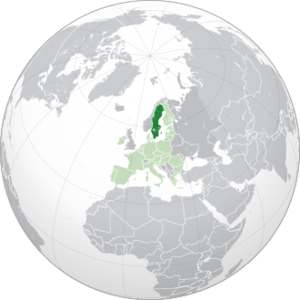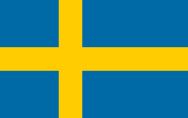Sweden
| Kingdom of Sweden |
|
(and Sweden's largest city) |
Source information is available at [ Sources ] |
Sweden (Swedish: Sverige - officially the Kingdom of Sweden (Swedish: Konungariket Sverige, is a Nordic country in Northern Europe. It borders Norway to the west and north, Finland to the east, and is connected to Denmark in the southwest by a bridge tunnel across the Öresund Strait. At 450,295 square kilometers (173,860 sq mi), Sweden is the largest country in Northern Europe, the third-largest country in the European Union, and the fifth-largest country in Europe. The capital and largest city is Stockholm. Sweden has a population of 10.4 million and a low population density of 25 inhabitants per square kilometer (65/sq mi). 87% of Swedes live in urban areas, which cover 1.5% of the entire land area. The highest concentration is in the central and southern half of the country.
History
Sweden is part of the geographical area of Fennoscandia. The climate is generally mild for its northerly latitude due to significant maritime influence. Despite its high latitude, Sweden often has warm continental summers between the North Atlantic, the Baltic Sea, and vast Russia. The general climate and environment vary significantly from the south and north due to the vast latitudinal difference, and much of Sweden has reliably cold and snowy winters. Southern Sweden is predominantly agricultural, while the north is heavily forested and includes a portion of the Scandinavian Mountains.
Germanic peoples have inhabited Sweden since prehistoric times, emerging into history as the Geats (Swedish: Götar) and Swedes (Svear) and constituting the sea peoples known as the Norsemen. An independent Swedish state emerged during the early 12th century. After the Black Death in the middle of the 14th century killed about a third of the Scandinavian population, the dominance of the Hanseatic League in Northern Europe threatened Scandinavia economically and politically. This led to forming the Scandinavian Kalmar Union in 1397, which Sweden left in 1523. When Sweden became involved in the Thirty Years' War on the Protestant side, an expansion of its territories began, and eventually, the Swedish Empire was formed. This became one of the great powers of Europe until the early 18th century. Swedish territories outside the Scandinavian Peninsula were gradually lost during the 18th and 19th centuries, ending with Russia's annexation of present-day Finland in 1809. The last war in which Sweden was directly involved was in 1814, when Norway was militarily forced into a personal union, which peacefully dissolved in 1905. Since then, Sweden has been at peace, maintaining an official policy of neutrality in foreign affairs. In 2014, Sweden celebrated 200 years of peace, breaking even Switzerland's record for peace. Sweden was formally neutral through both world wars and the Cold War, albeit Sweden has since 2009 openly moved towards cooperation with NATO.
Sweden is a constitutional monarchy and a parliamentary democracy, with legislative power vested in the 349-member unicameral Riksdag. It is a unitary state divided into 21 counties and 290 municipalities. Sweden maintains a Nordic social welfare system that provides citizens with universal health care and tertiary education. It has the world's eleventh-highest per capita income. It ranks very highly in quality of life, health, education, protection of civil liberties, economic competitiveness, income equality, gender equality, prosperity, and human development. Sweden joined the European Union on 1 January 1995 but has rejected NATO membership, as well as Eurozone membership, following a referendum. It is also a member of the United Nations, the Nordic Council, the Council of Europe, the World Trade Organization, and the Organisation for Economic Co-operation and Development (OECD).
Spanking in Sweden
Spanking was common in Sweden until the 20th century. Traditional spanking was birching, but a variety of other implements, e.g., canes and belts, were also used.
In the 20th century, school corporal punishment fell out of fashion and was gradually banned in many countries, a trend that continues until the present day.
As of May 2008, Sweden prohibits corporal punishment in schools.
Sweden was the first country worldwide to make the spanking of children illegal, not only in school but also for parents. This law was passed in 1979 and persists to the present day.
Swedish spanking art
Swedish spanking artists include Mr. KD and C. of Sweden
Apparently Sweden has an absurd law which criminalizes artistic depictions of minors in certain positions, including being spanked, on the grounds that such drawings or paintings might have been copied from a photograph. Although spanking children has been technically illegal in Sweden since 1979, there are no criminal penalties or fines for breaking this law. But apparently in Sweden, drawing a picture of an imaginary juvenile spanking constitutes a more serious offense than forcing the real thing on an unconsenting screaming child, since Mr. KD did receive a fine for his artwork.
Mr. KD is a Swedish artist of girl spanking art.
He is the first artist anywhere known for being prosecuted for juvenile spanking drawings. In 2004, Mr. KD was tried, convicted and fined (based on Swedish law) on the accusation that his child spanking art drawings constituted child pornography. For more information on the case, see the discussion on the Handprints website.
HandPrince stressed the fact that child spanking art such as Mr. KD's is perfectly legal unter U.S. law. The only way it could be illegal in the U.S. was if it constituted "obscenity", which is nearly impossible to prove and which is virtually never pursued for drawings and paintings. HandPrince confirmed: "No images on Handprints come close to meeting the U.S. obscenity standards, which permit materials of a far more obvious prurient nature with far less redeeming artistic value than anything on this site."
Other countries' law may differ, as Mr. KD's case in Sweden proved. This shows how important it is these days for spanking artists around the globe to know their local laws regarding the liberty of art and their national legal definitions of (child) pornography.
Spanking videos
- A Twig Spanking in the Swedish Forrest (LCAA, 2023), Lea, outdoor spanking, photos
- Affair at the Swiss School (Nu-West/Leda Productions, 1984), Swedish amateur actress Ingrid as Miss Brandt, set in Swiss finishing school (photos, video).
- Reissued in 2012 as Swiss School for Girls
- Alice and the Broken Glass (Swedish Discipline), photos
- Alice Caned in Bed (Swedish Discipline)
- Alice: First Spanking (Swedish Discipline), photos
- Alice: Late Night Out (Swedish Discipline), photos
- The Anna Svensson Collection (A) (Firm Hand Spanking, 2004-06), Anna spanked by Carole Mansbridge (photos, part C photos, part E photos, part F photos)
- Bath Brush Spanking (LCAA), photos
- Be Careful What You Wish For (Swedish Discipline), self-spanking, photos
- Caning for Schoolgirl Jessie (Swedish Discipline), photos
- Diana Caned on her Bare Bottom (Swedish Discipline), photos
- Diana Home Late (Swedish Discipline), photos
- Diana, Mouthsoaping and Leatherbelt (Swedish Discipline), photos
- Diana, Paddled Nude (Swedish Discipline), photos
- Diana, Spanked Upon Arrival (Swedish Discipline), photos
- Discipline South Africa Style (Nu-West/Leda Productions, 1988), Kiri Kelly
- recreation of actual 1959 caning in Capetown of Swedish stewardess arrested for violating the country's racial segregation laws (blog article, photos)
- Filthy Little Alice (Swedish Discipline), caught watching pornography, photos
- Happy Valentine from Alice (Swedish Discipline), photos
- Humiliating Punishment For Lea (LCAA), humiliation, photos
- International Relations (Spanked Cheeks, 2017), Swedish boss, Miss Lina, spanks secretary Amelia Jane Rutherford (photos)
- Nu-West Screen Test #1 (Nu-West/Leda Productions, 1984), introduces first-time Swedish actress Ingrid (see Affair at the Swiss School) (video)
- Penny's Punishment (Swedish Discipline), photos
- Pure Canings (Swedish Discipline), compilation video, photos
- Roseanna and The Belt (Swedish Discipline), photos
- Roseanna OTK Spanking (Swedish Discipline), photos
- Schoolgirl Linn, Spanked & Paddled, aka Naughty Linn, Spanked & Paddled (Swedish Discipline), photos
- She Broke the Rules (Well Smacked Seat), Miss Elsa Svenson, vaulting-buck, photos
- Spanked Wives (Nu-West/Leda Productions, 1984), Swedish amateur Ingrid (in 2nd segment), video
- The Swedish Affair (Spanking for Pleasure), video
- Swedish birching outdoors (Livslust Sweden Visar), video
- Swedish Lashes (California Star)
- Swedish Lessons (Spanked Cheeks), Leia-Ann Woods, Miss Lina, photos
- These Girls Must Be Caned! (Paradox/Spanking for Pleasure, 2002), Swedish exchange students Sophie and Marianne in UK school, photos
- Time To Repent (Well Smacked Seat), Miss Elsa Svenson as a nun, photos
- Vanessa From Sweden Joins RLS (Real Life Spankings), photos
- Vanja and the Carpet Beater (Swedish Discipline), carpet beater, photos
- Winner's Choice (Nu-West/Leda Productions, 1984), with Swedish actress Ingrid.
Sources
| List of Spanking Implements |
|---|
|
See "sting and thud" for more on this distinction. |
External links
- Mr. KD gallery 1 on Handprints (F/G, M/G)
- Mr. KD gallery 2 on Handprints (F/G, M/G)
- Mr. KD gallery with 27 images on Fenekelõs rajzok
- Who is Mr K.D. on the Encyclopedia of Spanking Art
- Mr. KD gallery 1 on the Encyclopedia of Spanking Art
- Mr. KD gallery 2 on the Encyclopedia of Spanking Art
- Mr. KD gallery 3 on the Encyclopedia of Spanking Art
- Mr. KD gallery 4 on the Encyclopedia of Spanking Art
- More information is available at [ Wikipedia:Sweden ]
Chat rooms • What links here • Copyright info • Contact information • Category:Root

